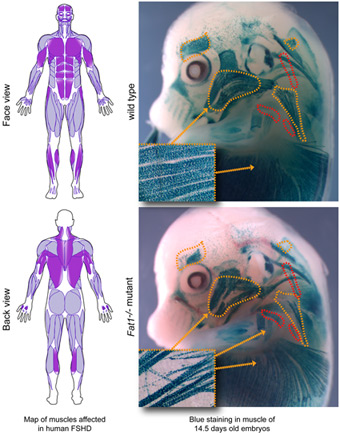Facioscapulohumeral muscular dystrophy (FSHD) is a hereditary human myopathy, affecting groupes of muscles in the face and shoulder, mainly caused by the contraction of a macrosatellite array on chromosome 4q35. The mechanism by which this triggers the disease has long represented one of the most enigmatic conundrums for human geneticists. Progress has been made in recent years with the identification of DUX4, a transcription factor encoded in a repeated 4q35 macrosatellite, produced in excess in FSHD and toxic for muscle (comprehensive review in Tawil et al., 2014). DUX4 activation results from the combination of a polymorphism stabilizing its RNA, with additional modifications that enhance DUX4 transcription by interfering with a mechanism of epigenetic silencing. Patients with identical DUX4-activating contexts can vary a lot in disease severity, ranging from childhood onset with severe phenotypes, to asymptomatic elderly carriers. This implies the existence of additional genetic FSHD-modifier genes contributing disease onset and severity.
We identified the 4q35 FAT1 gene as one such FSHD-modifier.

We initially identified the Fat1 Cadherin as a novel regulator of myogenesis in mice, controlling morphogenesis of subset of muscles (Caruso et al., Plos Genetics, 2013). The topology of muscle phenotypes exhibited by Fat1 mutant mice was highly reminiscent of the map of muscles affected in FSHD patients, and Fat1 mutant mice also exhibited non-muscular FSHD-like phenotypes (Caruso 2013). In collaboration with the groups of Nicolas Levy and Marc Bartoli (Marseille Medical Genetics Unit) and of Julie Dumonceaux (UCL), we collectively established a link between between dysregulation of FAT1 and FSHD: (1) we found that FSHD muscles exhibit lowered FAT1 levels at fetal (Caruso 2013) and adult (Mariot et al., Annals of Neurology, 2015) stages; (2) we identified pathogenic FAT1 variants in FSHD-like patients, affecting either RNA/protein structure (Puppo et al., Human Mutation, 2015), or deleting a putative cis-regulatory enhancer in the FAT1 gene (Caruso 2013). These data are compatible with the idea that FAT1 represents an FSHD modifier gene, which deregulation co-occurs with FSHD, thereby contributing to defining the topography of symptoms.
A more complete description of these findings is available here.
Following the identification of an FSHD-associated Copy Number Varian (CNV) deleting a putative intragenic FAT1 enhancer, we have followed up this possibility and investigated the transcriptional activity of this putative enhancer in vivo. We found this enhancer to drive expression in developing myofibers and in muscle-associated mesenchymal cells at selective subset of muscle extremities (relevant to Fat1-deficiency phenotypes). We discuss the possible functional implications of such a deletion, and propose how heterozygous deletions of this enhancer may act as disease modifier when associated with FSHD (Caruso et al., 2022, biorxiv).
Publications
2022
Nathalie Caruso, Angela K. Zimmermann, Tarana Nigam, Celine Becker, Karelia Lipson, Françoise Helmbacher. “An intragenic FAT1 regulatory element deleted in muscular dystrophy patients drives muscle and mesenchyme expression during development” Biorxiv (2022), September 17 | doi: 10.1101/2022.09.14.507898 | PDF |
2018
Helmbacher F. Tissue-specific activities of the Fat1 cadherin cooperate to control neuromuscular morphogenesis. PLOS Biology (2018) 16(5) e2004734 | PMID: 29768404 | doi: 10.1371/journal.pbio.2004734 |
2015
Puppo F., Dionnet E., Gaillard MC., Gaildrat P., Castro C., Vovan C., Bertaux K., Bernard R., Attarian S., Goto K., Nishino I., Hayashi Y., Magdinier F., Krahn, M., Helmbacher, F., Bartoli, M, and Levy, N. (2015). Identification of variants in the 4q35 gene FAT1 in patients with a Facioscapulohumeral dystrophy (FSHD)-like phenotype. Human Mutation, 2015, 23 JAN. DOI: 10.1002/humu.22760 | PMID 25615407 |
2015
Mariot V, Roche S, Hourdé C, Portilho D, Sacconi S, Puppo F, Rameau P, Caruso N, Delezoide AL, Desnuelle C, Bessières B, Collardeau S, Feasson L, Maisonobe T, Magdinier F, Helmbacher F., Mouly V, Butler-Browne G. Dumonceaux J. Correlation between low FAT1 expression and early affected muscle in FSHD. Annals of Neurology, 2015, MAY 28. | PMID: 26018399 |
2013
Caruso N., Herberth B., Bartoli M., Puppo F., Dumonceaux J., Zimmermann A., Denadai S., Lebossé M., Roche S., Geng L., Magdinier F., Attarian S., Bernard R., Maina F., Levy N. and Helmbacher F. (2013). Deregulation of the protocadherin gene FAT1 alters muscle shapes: implications for the pathogenesis of Facioscapulohumeral dystrophy. PLoS Genet. (2013) Jun;9(6):e1003550. | PMID: 23785297 | doi: 10.1371/journal.pgen.1003550 |